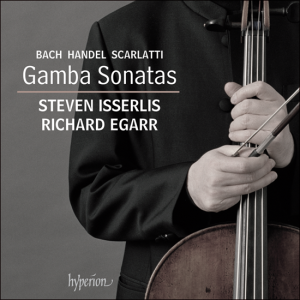Authentic instruments?
 Hyperion Records recently released the disc I made with the harpsichordist Richard Egarr of Bach’s sonatas for viola da gamba and keyboard, coupled with arrangements for cello of sonatas for violin and continuo by Handel and Scarlatti (with Robin Michael kindly supplying the cello continuo). To my surprise, some people have questioned, not why I recorded these gamba sonatas on the cello – which is what I was expecting them to ask – but why I recorded them with harpsichord rather than piano. I’m glad that nobody has complained (to me, anyway) about my playing them on my cello. They were of course written for the gamba, and sound wonderful on that instrument (when it’s properly played). But since the cello can play almost every note in the three sonatas at the same pitch, playing them on the cello is an obvious and satisfactory alternative. Besides, the first sonata exists in a version for two flutes and continuo, while the second and third are likely also to have been arranged by Bach (or originally composed, even) for other instruments; so I cannot imagine that Bach would have objected to having them played on the cello.
Hyperion Records recently released the disc I made with the harpsichordist Richard Egarr of Bach’s sonatas for viola da gamba and keyboard, coupled with arrangements for cello of sonatas for violin and continuo by Handel and Scarlatti (with Robin Michael kindly supplying the cello continuo). To my surprise, some people have questioned, not why I recorded these gamba sonatas on the cello – which is what I was expecting them to ask – but why I recorded them with harpsichord rather than piano. I’m glad that nobody has complained (to me, anyway) about my playing them on my cello. They were of course written for the gamba, and sound wonderful on that instrument (when it’s properly played). But since the cello can play almost every note in the three sonatas at the same pitch, playing them on the cello is an obvious and satisfactory alternative. Besides, the first sonata exists in a version for two flutes and continuo, while the second and third are likely also to have been arranged by Bach (or originally composed, even) for other instruments; so I cannot imagine that Bach would have objected to having them played on the cello.
I have absolutely nothing against hearing Bach played on the modern piano, either – in fact, I listen to artists such as Andras Schiff doing so all the time (and I’ve even been lucky enough to perform the gamba sonatas with him). Although Bach is, of course, a master of instrumental texture, those textures are eminently adaptable; so long as one can hear clearly the shape and forms of the music, his genius can shine out unimpaired in almost any instrumental combination. So why the harpsichord on this recording?
Well, what really attracts me is the clarity, the lucidity of the harpsichord, the fact that one can somehow hear through the sound. The piano is certainly a more sensual instrument; but the simplicity of the harpsichord is something else. Of course, one needs a player who can make the harpsichord sing, and overcome the instrument’s limitations. I remember that at one of my first-ever rehearsals with Richard, some years ago, I suggested doing a crescendo at one point; but then added: “Oh no – you can’t do that on the harpsichord, can you?’ He gave me a less-than-loving look, used language that would bring a blush to the cheeks of my innocent Facebook readers – and then produced (I still don’t know how) an entirely convincing crescendo from his instrument. I reminded him of that at the recording sessions. ‘You have to imagine the sound you want, and it’ll come,’ was his reply.
Another advantage of playing these sonatas with harpsichord lies in the issue of balance. With a modern piano, the cellist sometimes has to play louder than I feel the music demands; with a harpsichord, the danger is the other way around (and I must admit that I do feel that the cello is perhaps a little too present at times on our recording). But having to play softly is a luxury for a cellist; and it makes it easier for the bow to dance uninhibitedly, as this music requires. Notwithstanding Richard’s magic tricks, there is less dynamic range in a harpsichord than in later instruments; so a lot of the structure is expressed through subtle rhythmic changes, which should (I think) be unnoticeable to the listener. I once heard Rostropovich put that idea in a lovely way: he advised someone not to change the tempo, but to move it on ‘like the nose of the dog pointing forward’.
So one plays in a somewhat different way when playing with harpsichord than with piano – but the essence of the music remains the same. What amazing works they are – deeply moving, unbelievably imaginative, wonderfully vivid; the better one knows them, the more miraculous they seem. And ultimately, one has to play them with conviction, hoping to convey their magic, without fussing too much about theories of authenticity. I’ll leave the last word to the colourfully-spoken Mr Egarr. At one point in the recording, I stopped and asked him: ‘What will I tell people who say that I should have started that trill on the upper note?’ “Tell them to f— off”, Richard replied brightly. Ahem – but he has got a point…